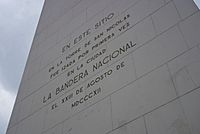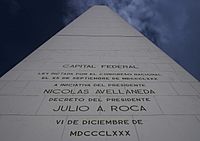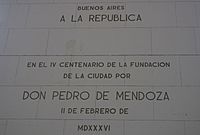Obelisco de Buenos Aires facts for kids
Quick facts for kids Obelisco de Buenos Aires |
|
|---|---|
 |
|
| Location | Av. 9 de Julio and Av. Corrientes, Buenos Aires |
| Height | 71.5 meters (235 ft) |
| Built | May 23, 1936 |
| Built for | Monument |
| Restored | 2005 |
| Architect | Alberto Prebisch |
| Lua error in Module:Location_map at line 420: attempt to index field 'wikibase' (a nil value). | |
The Obelisco de Buenos Aires (which means Obelisk of Buenos Aires) is a famous landmark and a national historic monument in Buenos Aires, Argentina. It stands tall in the Plaza de la República, where two big avenues, Corrientes and 9 de Julio, meet. This impressive monument was built in 1936. It celebrates 400 years since the very first time the city was founded.
Contents
History of the Obelisco
The construction of the Obelisco started on March 20, 1936. It was finished very quickly, on May 23 of the same year. The architect who designed it was Alberto Prebisch. He was a key architect in Argentina's modern style. He also designed the Teatro Gran Rex.
The mayor of Buenos Aires at the time, Mariano de Vedia y Mitre, asked for the Obelisco to be built. The project cost 200,000 Argentine pesos. Workers used 680 cubic meters of concrete and 1,360 square meters of white stone from Córdoba, Argentina.
The German company G.E.O.P.E. - Siemens Bauunion - Grün & Bilfinger built the Obelisco. They finished the work in a record 31 days, with 157 workers. They used a special fast-drying cement. The monument was built in sections, each about 2 meters high. This made it easier to pour the concrete.
The Obelisco is 67.5 meters tall. The main part is 63 meters high, leading up to the top section. The very tip is blunt and has a lightning rod. You can't see the lightning rod from the ground because it's so high up. Its cables run inside the monument.
There is only one entrance to the Obelisco, on its west side. At the very top, there are four windows. To reach them, you have to climb a straight staircase with 206 steps. There are 7 small resting areas along the way.
Why Was the Obelisco Almost Demolished?
In June 1939, the city council decided to tear down the Obelisco. They said it cost too much, didn't look good, and wasn't safe for the public. However, the mayor, Arturo Goyeneche, stopped this plan. He said it was a national monument and part of Argentina's history. So, the Obelisco was saved!
What Was Here Before?
Before the Obelisco was built, there was a church on this spot. It was called the Church of St. Nicholas of Bari. This church was torn down to make space for the monument. An interesting fact about that church is that the Argentine flag was officially raised there for the first time in Buenos Aires, back in 1812. This important event is mentioned in one of the inscriptions on the north side of the Obelisco.
Changes to the Obelisco
In 1938, some pieces of the stone covering started to fall off. This happened after a big public event. Because of this, in 1943, the stone covering was removed. It was replaced with polished cement. This new surface had lines to make it look like stone blocks. When the old slabs were removed, a message saying "Its architect was Alberto Prebisch" was also taken away.
Special Events and Meanings
Over the years, the Obelisco has been used for many special events. In 1973, it was decorated like a giant Christmas tree.
In 1975, during a time of political tension, a rotating sign was placed around the Obelisco. It said El silencio es salud (Silence is health). This message was meant to tell drivers not to make too much noise. But many people thought it was a message telling Argentines not to share their political opinions.
Protecting the Monument
The Obelisco has sometimes been damaged by graffiti, especially political messages. In the 1980s, some activists even spilled paint from the top windows. Because of this, the city government put a fence around the base of the Obelisco in 1987. This helped to stop most of the damage.
In 2005, the Obelisco was fully cleaned and repainted. It was given a new color, a "Paris stone" hue, which is a pleasant light gray. This made it look much better than the old white paint.
To remember the 30th anniversary of "La Noche de los Lápices" (The Night of the Pencils), the monument was once turned into a giant pencil.
The Obelisco is easy to reach by public transport. Several subway lines (B, C, and D) have stations nearby. These stations are connected by underground passages with shops.
The Obelisco also hosted the opening ceremony for the 2018 Summer Youth Olympics.
Inscriptions on Its Sides
The Obelisco has special messages carved into each of its four sides. These inscriptions tell important parts of Buenos Aires's history.
| North side | West side | South side | East side |
|---|---|---|---|
 |
 |
 |
 |
| Translation: On this site in the St. Nicholas tower the National Flag was hoisted for the first time in the city the XXIII of August of MDCCCXII. |
Translation: Federal Capital Law enacted by the National Congress the XX of September of MDCCCLXXX initiative of the President Nicolás Avellaneda Decree of the President Julio A. Roca VI of December of MDCCCLXXX. |
Translation: Second Foundation by Juan de Garay XI of June of MDLXXX. — Poem by Baldomero Fernández Moreno |
Translation: Buenos Aires to the Republic On the IV centenary of the foundation of the city by Don Pedro de Mendoza. II of February of MDXXXVI. |
On the south side, there is also a small inscription with a poem. It was written by Baldomero Fernández Moreno. The poem describes the Obelisco as a "shining silver sword" pointing to the sky. It talks about how the monument helps people look up and feel inspired. It compares the Obelisco to a "moonbeam," a "fountain," a "flame," and a "palm tree." The poem suggests that ideas, dreams, and hard work should all revolve around this important symbol.
Special Occasions
-
Millions celebrating world championship of the 2022 FIFA World Cup
Images for kids
See also
 In Spanish: Obelisco de Buenos Aires para niños
In Spanish: Obelisco de Buenos Aires para niños











